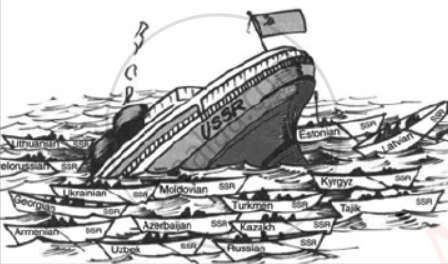Advertisements
Advertisements
प्रश्न
What is the full form of “SAARC”?
उत्तर
SAARC stands for South Asian Association for Regional Cooperation.
APPEARS IN
संबंधित प्रश्न
Mention any four names of the countries belonging to the SAARC
Which among the following statements that describe the nature of the Soviet economy is wrong?
Fill in the blank:
_________________ was the military alliance started by the USSR.
Fill in the blank:
____________________ party dominated the Soviet Union’s political system.
Mention any three features that distinguish the Soviet economy from that of a capitalist country like the US.
The Soviet Union invaded Afghanistan in the year ____________.
The successor country to the Soviet Union is ____________.
The revolution of Russia in 1917 was inspired by Ideals?
The warsaw pact was ____________.
The collapse of which country is known as the collapse of ‘Second World’.
In which year Warsaw Pact was disbanded?
How many Union Republics were there in U.S.S.R.?
Which leader of the U.S.S.R. started political and economic reforms in U.S.S.R.?
Study the following diagram and answer accordingly.

What led to the dissolution of the Soviet Union?
Read the following passage and answer accordingly.
A coup took place in 1991 that was encouraged by Communist Party hard-liners. The people had tasted freedom by then and did not want the old style rule of the Communist Party.
Boris Yeltsin emerged as a national hero in opposing this coup. The Russian Republic, where Yeltsin won a popular election, began to shake off centralised control.
Power began to shift from the Soviet centre to the republics, especially in the more Europeanised part of the Soviet Union, which saw themselves as sovereign states. The Central Asian republics did not ask for independence and wanted to remain with the Soviet Federation.
In December 1991, under the leadership of Yeltsin, Russia, Ukraine and Belarus, three major republics of the USSR, declared that the Soviet Union was disbanded.
The Communist Party of the Soviet Union was banned. Capitalism and democracy were adopted as the bases for the post-Soviet republics.
The declaration on the disintegration of the USSR and the formation of the Commonwealth of Independent States (CIS) came as a surprise to the other republics, especially to the Central Asian ones.
The exclusion of these republics was an issue that was quickly solved by making them founding members of the CIS. Russia was now accepted as the successor state of the Soviet Union.
It inherited the Soviet seat in the UN Security Council. Russia accepted all the international treaties and commitments of the Soviet Union. It took over as the only nuclear state of the post-Soviet space and carried out some nuclear disarmament measures with the US. The old Soviet Union was thus dead and buried.
Which were the three major republics of the USSR?
Read the following passage and answer accordingly.
Economist Jeffrey Sachs is widely associated with shock therapy. He developed a plan of shock therapy for post-communist Poland in 1990, for post-communist Russia in 1992, and several other countries, including Bolivia and Chile.
Bolivia, in particular, in 1985, had success as a result of shock therapy in ending a period of hyperinflation.
Poland also initially seemed to benefit from shock therapy as inflation was controlled, but it saw a sharp rise in unemployment that peaked at 16.9%.
Sachs did not like the term shock therapy, which he said was coined by the media and made the reform process sound more painful than it was.
In Russia, neo-liberal shock therapy did not produce favourable outcomes. Shock therapy was applied swiftly and in large scale, as opposed to how it was applied to other nations.
Almost all of Russia’s industries were undervalued and sold to private individuals and companies, with most acquired by a few Russian oligarchs.
With limited government intervention, most industries disappeared. The Russian currency declined, causing high inflation and the erosion of most citizens’ savings. Unemployment increased drastically, and government subsidies were removed, further pushing Russian families into poverty.
Who developed the plan of the Shock therapy for the post-communist Poland?
Who was the founder head of the USSR during the most difficult period following the revolution (1917-1924)?
Which group of countries was called the Second World or the 'socialist bloc'?
The Union of Soviet Socialist Republics (USSR) came into being after the Socialist Revolution in Russia in
Which one of the following statements was not a feature of the Soviet System?
Which of the following statements was not a feature of the Soviet System?
Which of the following factors makes Russia a powerful country in the world?
”The Soviet Union became a great power after the Second World War. However, in no time, the Soviet system became bureaucratic and authoritarian making life difficult for its citizens.” Do you agree with the given statement? Give arguments to prove your answer.
